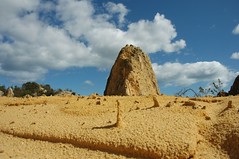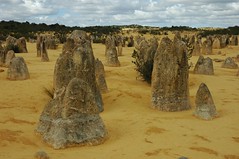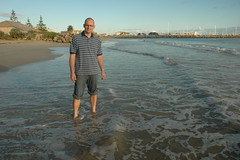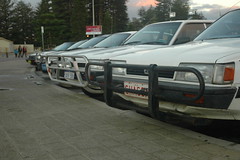“Fremantle In The Fifties.”
A History of Fremantle, between 1850 and 1860, with particular reference to convicts.
Ronald Chamberlain,
Teachers' College,
Claremont.
1959.
Chapter 3. “The System in Western Australia”The colonists had brought out the convicts. Now they were presented with the problem of instituting a system in the colony. The basic ideas which caused convicts to be brought out and the way in which they were set to work are discussed. Here the general life of the convict is discussed from his daily timetable to systems of promotion and the cultural activities open to him. An important question which was continually raised was that of the guards available. This proved to be a problem which was not easily solved.
Even though Western Australia was lifting to a state of prosperity, she still found that much care had to be exercised. Had the Governor set the convicts building roads and bridges then the state would have undoubtedly continued to feel many of the hardships she had previously experienced. The colonists required the convicts to be sent out not to build roads and make similar i\improvements, which were indeed necessary, but to help on the farms. Help was needed to conquer this huge country. One man could not cope with the huge tracts of land required to be cultivated to meet the needs of the community as regards food. Convicts were, therefore, sent out to work on the farms and to such districts as York which had an important force in first establishing convicts in Western Australia. Because of this outlook of working on the most important requirements first, the governor had very few convicts directly at his disposal. The convicts were hired out first of all from Fremantle and then from other depots, such as North Fremantle and Guildford. The price was £2.10.0 per head per year. At first the government supplied food but later the farmers had to keep the convict. This £2.10.0 was meant to repay the British Government for the cost of a passage on the ship. Many cautions were shown in the Government Gazette warning people who were holding convicts, to pay their money into an appropriate depot by a certain date. Even though most of the convicts were reasonably well behaved, some caused a good deal of trouble. These convicts were detained at the main establishment in Fremantle.
The 1852 gold rush in Victoria had the effect of stirring many of the men in Western Australia to the gold fever stage. Fremantle, at the time, along with most other areas of the state was showing what could be done with help. It would have been a bad state of affairs had many of the men gone to Victoria. A law was passed by the governor preventing free men from leaving the state to seek their fortunes in the hills around Ballarat and Bendigo. This law was contrary to democratic law-making, but it did have the desired effect of helping Western Australia stable, while all of the other states were losing large proportions of their populations to Victoria.
As “improvements” were made to the Esplanade Hotel, it became more and more like a regular gaol. Gradually a timetable was imposed upon the convicts. As time went by, the timetable became very strict. For the most of the time the system operated in Western Australia a timetable similar to the one below always existed in the main establishment.
5.00am. - Bell - day begun.
5.15 am. - Roll - call and march to wash room.
5.55 am. - Off to work.
7.55 am. - Return for breakfast.
8.25-45. - “Smoke” and prayers read.
1-2pm. - Midday dinner and “smoke”
6.15pm - Supper.
6.45-730 -Men could associate in exercise yard.
7.30pm -Prayers.
8.00pm - Lights out.
By late 1852 the new school system in the Establishment was in full swing. Everyman was required to attend at least once per week. The school was held twice a week. Lectures were given by many prominent citizens, including the Governor, or Captain Henderson, together, with many of the convicts themselves, who were either well informed men or interested in becoming informed. An important media of learning was the library, but it was considered inadequate and narrow by some, but did give the men the chance to find out more about the world in which they lived. The main subjects taught were the 3-R's, but the use of library books and lectures widened the course and proved most stimulating to the man. In a half yearly report of the Comptroller-General it was reported that 400 out of the 570 in the prison had books delivered to them at their own request. Although there were 600 books in the library, 500 of these treated religious subjects. This must have been pleasing to the local clergy, but was a little disheartening to some of the convicts who wished to widen their scope of knowledge as their fancy took them. It was further reported that:-
“Only a few did not wish to attend school and practically without exception these were ignorant men.”
The series of lectures was an interesting feature of the course. The Governor expressed his gratification over the new interest shown by the convicts when he lectured to them. The title of the Governor's topic at the time was “Mineralogy in connection with mining and the metalferous deposits of the Colony.” This does not appear to be a particularly inspiring topic, and for the convicts to show the interest expressed by the Governor shows either the Governor's ability as a lecturer or the convicts ability to look interested, or both. Cultural interests were high and on Saturday mornings, singing classes were held. (Along with the glowing reports of the progress of the school system, came the Surgeons report that the hospital was totally inadequate for the purpose of caring for the sick.)
With the convict system growing as regards numbers, the need for more clergymen became obvious. One man was serving the religious needs of about 600 prisoners, many of whom were not of his religious conviction, and so refused to have anything to do with him. This latter group was the Roman Catholic prisoners, who predominated the Irish numbers sent out. Fitzgerald asked for more clergymen, and in particular a Roman Catholic Bishop. The religious differences had serious repercussions as the system developed, and the number of Irish prisoners sent out increased.
The general conduct of the prisoners was improved by the natural environment of Western Australia. The Eastern Colonies had climates and wild life in which a man could exist for years without dying from exposure. Western Australia was vast and open, settlements were scattered far and wide, consequently, if a man escaped he had no where to go. He could not escape from this “natural gaol”. Thomas H. Dinon expressed the following opinion of escape:
“So hopeless are the chances of success that it is only the occasional individual, grown desperate, and careless of consequences by the dreary monotony of an apparently endless imprisonment, or some new comer, ignorant of the nature of the colony or country and its complete isolation from the other colonies or some lunatic or idiot who would attempt to escape.”
Not only did the interior of Western Australia make it very difficult for a convict to escape, but the formation of a water police increased the difficulty. This service made it far more difficult for the men to escape to the north to Batavia, or to the south to one of the other states. The water police started in 1852 and later amalgamated with the land force to provide a more efficient method of preventing convict escapes.
Throughout his stay in Western Australia, Governor Fitzgerald was continually asking the Colonial Secretary that more guards be sent out, and that they be more reliable. From time to time a few men would be sent out to increase the numbers of the police force. On several occasions Governor Fitzgerald expressed the view that men used the job of warden as a “stepping-stone” to something better or as a “stop-gap” job. Rarely did wardens stay in the service long enough to give anyone in command a sense of a secure force carrying out operations. Fitzgerald also pointed out that in many cases the wardens were far too lenient with the men. This was possible the result of the “stop-gap" idea of the occupation. The pensioners who were replaced by a civil guard, but because the civil guard was lacking in numbers the pensioners had to be re-introduced to the work.
Among the conditions set down for convicts it was stipulated that one letter per three months could be sent home. This seems rather a long time between letters, but when one considers the time it would take to send a letter home, the time is not so long. Many of the convicts had little wish to send home any information about themselves, or the settlement. They were disgraces to England and a new life lay ahead of them out here. This idea of a “fresh” start out here was all very well, but many of the convicts had ties in England which could not be disposed of as easily as that. Here reference is made to the men who had wives and families in England and wished to marry out here. This became a problem for the local authorities as they had very little in the way of records of the men who had been transported. Clergymen were instructed not to marry ticket-of-leave men in Western Australia. Later on Earl Grey promised that accurate information would be sent which would clean up the predicament. With this new country open to them and their inability to return to England, many of the ticket-of-leave men wished to bring their wives out to Australia. Ticket-of-leave men could buy land and this made the idea more desirable. The convicts when they had payed for their own passages to Australia could pay for their wife's passage. Both Earl Grey and governor Fitzgerald could see the obvious moral advantages in this tendency to even up the sexes.
Because more men were entering the colony, due principally, to the fact that the convict system catered only for men prisoners the question as to how the disportion of sexes could be dealt with was, for Western Australia, a serious moral problem. The problem soon became the question as to whether female convicts would be allowed into the state. Many of the citizens were afraid of the serious moral consequences of convicts being sent out. The summing up of how Western Australia felt about the system can be seen n the following extract to Earl Grey.
“At Perth the majority are decidedly opposed to the measure, equally at York, at Fremantle the question, I hear, was carried for the introduction of female convicts by a majority consisting of ticket-of-leave men, who in my opinion, should never have been permitted to have a voice in the matter.”
Apart from the ticket-of-leave men who voted in favour of the introduction of female convicts, many prominent and respectable citizens expressed the idea that the introduction of female convicts would be a good thing. The ticket-of-leave men who were single obviously needed them to have a class of their own, with which to marry. The topic continued to be a point for much argument, even after Earl Grey had told the Governor that female convicts would not be sent to Western Australia.
When the ticket-of-leave man received his “ticket” it entitled him t go anywhere in the world except the United Kingdom. The Eastern States of Australia, being somewhat more profitable to work in than Western Australia found that many of our convicts were entering into their boundaries. This brought a cry from the moralists in these colonies, as they all, with the exceptions of Tasmania and Norfolk Island (whose systems ended in 1853 and 1855 respect.) abolished the convict system some five years earlier and expected to fairly rapidly lose the influences of the system. This fresh source from Western Australia found these colonies objecting strongly. Victoria even passed a law to prevent the entry of ex-convicts into that state. Naturally enough Western Australia did not want to lose any of these new citizens, for she found just how valuable they were.
When a convict had been freed he found that all was not rosy for him. In a court of law a ticket-of-leave man's word was not held in as high esteem as the word of a free man. This led to many ticket-of-leave men being scape-goats for a free man's crime. A fee man often used the free man's status to extract money in charging outrageous prices for goods which were necessities. An other stipulation as to the pattern of behaviors imposed on the ticket-of-leave man was that he could not hold a government position. This could have held back the state because very often ex-convicts were extremely capable men who shone n business and other occupations later on.
Within Western Australia were four types of prisoners which could be used to work for the government.
1.Probationary ticket-of-leave. These were men who could be sent to all parts of the colony to work for private employers. They had on many occasions served a probationary period in the Fremantle Establishment.
2.Reconvicted class. Those who had been granted their ticket-of-leave but had committed another crime. There were only a few in this class.
3.Free men who were convicted with the colony. The old roundhouse at the western end of High Street in Fremantle had been built in the 1830's for the purpose of housing this type.
4.ticket-of-leave men who could not find employment and who worked for the government. They were not criminals in the true sense of the word.
When Western Australia began the system the emphasis was to be on reform. Men were to be given the opportunities to bring out their good qualities, to strive to make themselves better, useful citizens. One method which did help was the use of the stripes system. The following is a summary of the intentions to make these men into better individuals.
“Such distinction be made between the classes and such privileges granted as shall promote the object of giving encouragement to those whose conduct may deserve it.”
The convicts were classified into groups such as “Very Good”, “Good”, “Bad” and “Very Bad”. By 1852 the strip system was introduced – 3 stripes were used for a first class convict, two for a second class and one for a third class. All the prisoners were kept informed of their class which aided the drive to move to a higher class. Pay increased as a convict went up a class, for example 2½ pence per day for a “very good” and 1½ pence per day for good. These amounts varied greatly over a period of time and it was worthwhile obtaining the highest class. Convicts, when they Achieved the rank of first-class could be used as a constable (a third class constable). After one year the convicts as constables were paid 2/6 per day. The system worked particularly well at Fremantle and by 1857, convicts were in charge of all road parties. In 1857 a marks system was introduced which would decrease the period a convict had to serve. This system was abolished in 1867.
In their own way the convicts were doing quite well. There were good opportunities for promotion and generally these promotions meant some valuable gain. Not only did this policy of reform help the convict, but it also helped Western Australia as a whole. She was producing a good type of citizen out of individuals who were the “scum of England”. While this reforming was in progress, a building was going up slowly but surely, in Fremantle. An Establishment for the convicts was being constructed.









